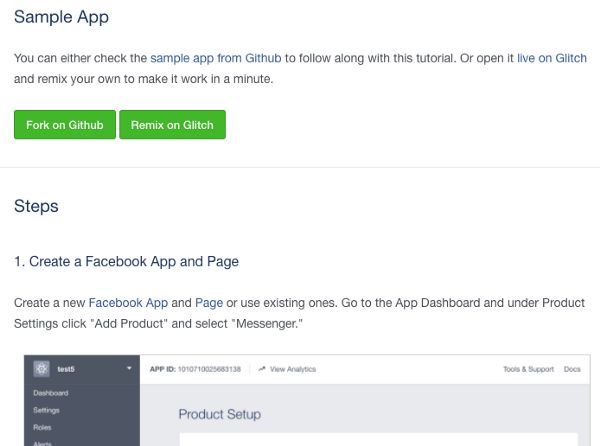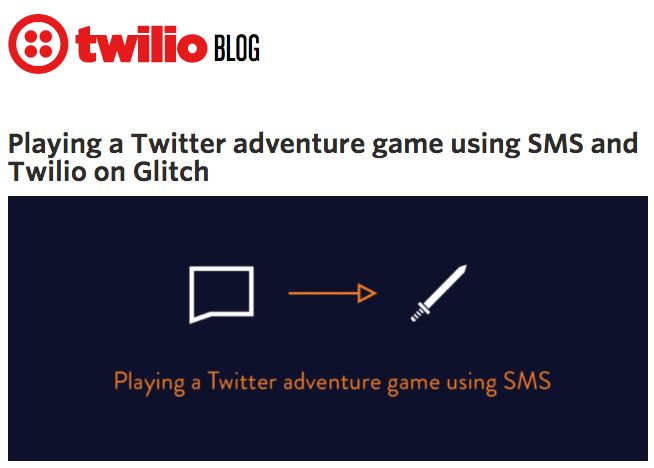9 Ways to Improve API Developer Experience
We recently released Glitch for Platforms, a dedicated set of tools specifically for Developer Relations. We’ve been previewing some of the features with partners for a few weeks, so let’s take a look at some of the ways Glitch for Platforms features are already being used in the wild.
One of the core features of Glitch is the ability to remix an app. This means anyone can copy and reuse the code from another project on Glitch, that they can tweak and personalize to make it their own. This is especially handy for those with an API or SDK, as it allows you to create sample apps that use your service, which folks can remix to quickly get started with to build their own apps.

This is exactly how Facebook are using Glitch in their Messenger quick-start documentation. They’ve created a simple template project on Glitch that shows off the key features of their Messenger API. They’ve linked it from their documentation so that you can “open it live on Glitch and remix your own to make it work in a minute.”
The lovely people over at Howdy have taken this even further for Botkit, their fab set of tools for creating and managing bots. They’ve created 3 customizable Starter Kits for building bots for Slack, Cisco Spark, as well as Facebook. You can remix them directly from their GitHub readme as they make use of our GitHub import links feature. Howdy Founder and CEO, Ben Brown, says “Glitch takes what could be a really complicated process and makes it a one-click operation.”
A staple of the Twilio blog is tutorial blog posts, walking people through code to create some example app. Twilio have used Glitch in their blog posts to not only explain the code in the example but provide an app that users can demo. This is useful both to understand what the finished product should look like, and to remix to try it out for themselves. Whether it be a fun SMS-powered adventure game or a core Node.js SMS sample project, Twilio have used Glitch-based example projects so that readers can skip the setup and instead focus on understanding aspects of the Twilio API.
A creative use of remixing is being employed by freeCodeCamp, a community to learn to code and build projects for nonprofits. In order to help people learn back-end development, they’ve created a number of partial projects that accompany their explanatory course material. Students can utilize what they’ve just learned in the course material and complete the partial projects to create a working app. Quincy Larson, Founder and Teacher at freeCodeCamp remarks that “Glitch does exactly what our community needs — it makes it trivial to build APIs, pipe them together with other services, then share the resulting applications”.

Code examples are a key part of any API documentation. Interactive documentation improves on this and allows you to try out real requests. However, this still has the limitation that you can’t take that working example with you, and replicating it can be time-consuming. That’s why for example, HyperApp, a JavaScript library for building frontend apps, use Glitch in their docs. By supplementing their code explanations with working examples, users are able to re-use and extend them for use in their own apps. HyperApp maintainer, Jorge Bucaran, explains that it’s this “simplicity and straightforwardness” that attracted them to use Glitch, and it’s delivering the ability to work with their code “without getting bogged down in details”.
The Glitch editor is collaborative. Multiple people can work on code together in real-time, like editing a Google doc. This means you can pair program and work together with your team at the same time, creating projects where all members have access to edit the code. But you can also allow visitors to just view your code too. When combined with audio sharing software, like Twitch or YouTube Live, you can eschew the grainy screen share and work on code while others watch you work directly in the editor. Webpack maintainer, Sean Larkin, did this while creating a live demo of Webpack’s lazy loading capabilities for example, with users watching and learning while he worked.
Glitch accelerates web development, and this is especially useful when at a Hackathon and time is limited. A lot of time can be lost deciding upon and getting started with the various technology choices. You can help Hackathon attendees to get up and running with your API by creating examples that they can work from. Take for example the recent Anvil Hack event, a creative Hackathon by Hacksmiths. Students were quickly utilizing Spotify and Twilio APIs by re-using existing apps to prototype their own using Glitch.
A recent addition to our platform is Glitch Help, which provides the ability for people to ask for help when they get stuck, in realtime. This is especially useful for developer relations teams as it means you can hop into their project and help people directly before they give up. This is something existing partners are already keen to utilize, like Wistia for example, who provide a number of sample apps embedded within their developer documentation.

We’ve built a friendly, welcoming community, and we’ve made sure that our outreach efforts regularly connect with underrepresented developers that other communities don’t serve. When you bring your platform to Glitch, you get outside the bubble of the developers you already know and a custom-branded gallery of sample apps for your API helps introduce them to your platform. Take for example the following collections that we created to coincide with the flagship conferences for Google, Microsoft and Facebook.
Lastly, I wanted to highlight A-Frame School, an interactive course for WebVR. Mozilla’s A-Frame team have put Glitch at the heart of their documentation by creating an interactive workshop based around their Glitch sample project. In their own words, they describe the advantages of using Glitch for this:
Thousands of people have already been introduced to A-Frame and WebVR by following this course.
Underpinning all of these examples are the advanced analytics provided by Glitch for Platforms. Our stats let you know how many people have tried and successfully used your sample projects. And when combined with web analytics and your own internal stats, this gives you complete insight into the entirety of your funnel — from viewing documentation, through to successfully creating an app and working with your API.
Through these activities, early adopters of Glitch for Platforms have already been able to optimize their funnel, generate more leads and improve outcomes for developers trying to use their APIs.

